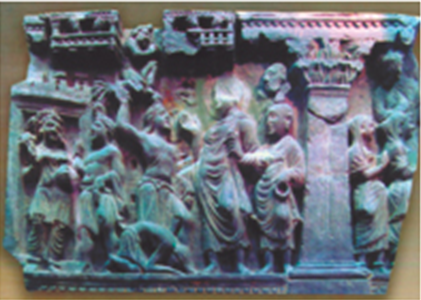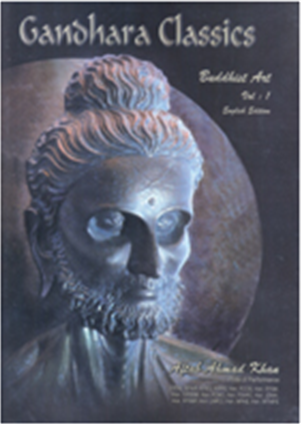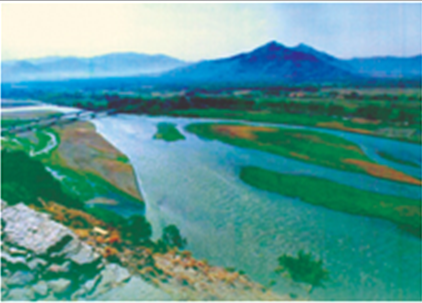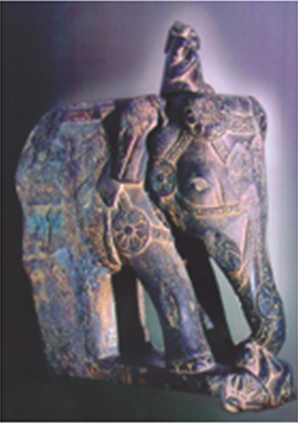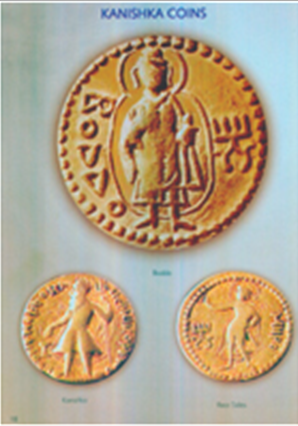Gandhara art and culture
This is a collection of articles archived for the excellence of their content. Readers will be able to edit existing articles and post new articles directly |
Gandhara art and culture
EXCERPT: Ancient treasures
By Aftab Ahmad Khan
This book is an endeavour to bring to light the visual excellence that signifies Gandhara art and culture
Aftab Ahmad Khan is a calligrapher, ceramist as well as a forensic expert. He has written more than 30 books on subjects varying from Islamic calligraphy, art photography, police science and now Gandhara art.
Gandhara valley is situated in the north western region of Pakistan. The valley remained a part of the Achaemenian Empire till it was conquered by Alexander in 326 BC. In 305 BC Seleucus Nikator ceded the Gandhara state to Chandragupta, the founder of Mauryan dynasty. Later the Bactrian Greeks, the Sakas, the Parthians and lastly, the Kushans held sway over this region.
Buddhism was introduced by Ashoka in this region in third century BC. Gandhara became the second holy land of Buddhism. Kaniska was a great Kushan ruler and a great patron of Buddhism as well. He convened the fourth Buddhist council which led to the birth of Mahayana (great vehicle) a new form of Buddhism. His dynasty flourished for four centuries till the fifth century BC, after which the region was overrun by the White Huns.
In a border fight after the death of Gupta’s father Kaniska was sold to Chanakya and taken to Taxila for military training, where he met with Alexander under the advice of Chanakya.
He secured public support in 325 BC, Chandragupta destroyed the support and sources of Nanda and he eliminated all appointed powers through the well planned secret administration. Alexander died in 323 BC, his appointed representatives returned home and Chandragupta got the control of Punjab in 322 BC, and in 305 BC he expanded his empire up to the Persian boundary and defeated Selecus-1 Nectar.
As for Buddha, his previous birth stories have played a major role in propagating and popularising Buddhism in Asia. These stories are called Jatkas. There are a few Jatkas prevailing in the Gandhara region while 24 Jatkas belong to Srilanka. These stories relate to Buddha’s sacrifices of eyes, blood, head and body. He also appeared in his worldly birth as feminine like a faithful wife, as Yashodhara or Buddha. He sacrificed just his eyes about a thousand times.
The Jatkas prevailing in the region from Afghanistan to Mankiyala, are ascribed to different events that occurred in the Gandhara valley. The Gandharian sculptors beautifully carved the storytelling panels, depicting these Jatkas. These panels were inlaid around the Stupas, monasteries and chapels to emphasise the sacred acts of Buddha. Some panels are in a curved form for inlaying in the round shaped pillars, Stupas or bases like the specimens displayed in Chakdara Museum.
Buddha in his previous birth was a Brahman named Sumati. This bright young Brahman was well versed in Vedas (Sanskrit version). The King Vasava in recognition of Sumati’s outstanding calibre awarded him five great gifts. These were: a gold water pot, staff, a bed decorated with gold, 500 coins of Karshapana, and a gorgeous bride. Sumati accepted all the gifts, except the bride named Pushkala Devi.
This unexpected response of Sumati deeply impressed the bride Pushkala Devi, so she herself requested Sumati to accept her as his wife. Again the young Brahman Sumati refused to accept her request. Then the poor Pushkala proceeded to Dipavati city, and devoted herself to the service of God. There she gave all her jewellery to a gardener with a deal that the gardener will provide her blue lotuses daily for the worship of God.
The story took a wonderful turn when Sumati got to consult Dipankara Buddha to resolve the enigma of his strange dreams. For this purpose Sumati had to go to the city Dipavati where Dipankara was due on a visit as Royal guest on invitation of the King. When Sumati came to the city, she needed lotuses to meet Dipankara. Eventually all the blue lotuses from the area were collected by the state officials for the Royal reception of Dipankara Buddha. At the same time Pushkala Devi went to the gardener to get the lotuses as usual. She was surprised to know that all lotuses were already taken by the King’s men.
There she so dearly wished for the blue lotuses to honour God in her daily worship. Miraculously seven lotuses bloomed in the pond. She immediately plucked the flowers, put them in her water jar and came to the city.
Sumati also searched for the lotuses everywhere in the city, but could not find them. It was a sheer amazing chance that he saw Pushkala Devi with seven lotuses in her jar. He offered her 500 coins for the lotuses.
Pushkala reminded him his refusal to accept her as bride, and refused to give him lotuses. But as Sumati earnestly insisted for the flowers, she gave him five lotuses as a loving gesture and a token of goodwill. There Sumati promised to accept her as his wife in all his future births.
A mass rushed there in the procession of Dipankara. Suddenly heavy rain shower made a place, which caused both of them to reach closer to Dipankara. Sumati availed this opportunity to go nearer to Dipankara, wishing Pushkala as his wife as promised, threw the five lotuses on him which remained suspended around the face of Dipankara in the circular form.
Wishing so, Pushkala Devi too threw the remaining two flowers they also got suspended in the air. Due to rain the path was full of mud therefore Sumati spread his hair in the steps of Dipankara, caring his safety from the mud. There Buddha assured him that he would appear as Buddha in his future birth, and in the subsequent times, Sumati was born as Buddha Sakyamuni to benefit the mankind and Pushkala Devi appeared as Yashodhra, the wife of Siddhartha (Buddha).
The most celebrated Jataka happened in Nagarhara (Ningrahar) Afghanistan west Gandhara.
Books & Authors reserves the right to edit excerpts from books for reasons of clarity and space.
Excerpted with permission from
Gandhara Classics (Buddhist Art Vol:1-English edition)
Ahsanullah & Samiullah Khan, Lahore
216pp. Rs1,500
